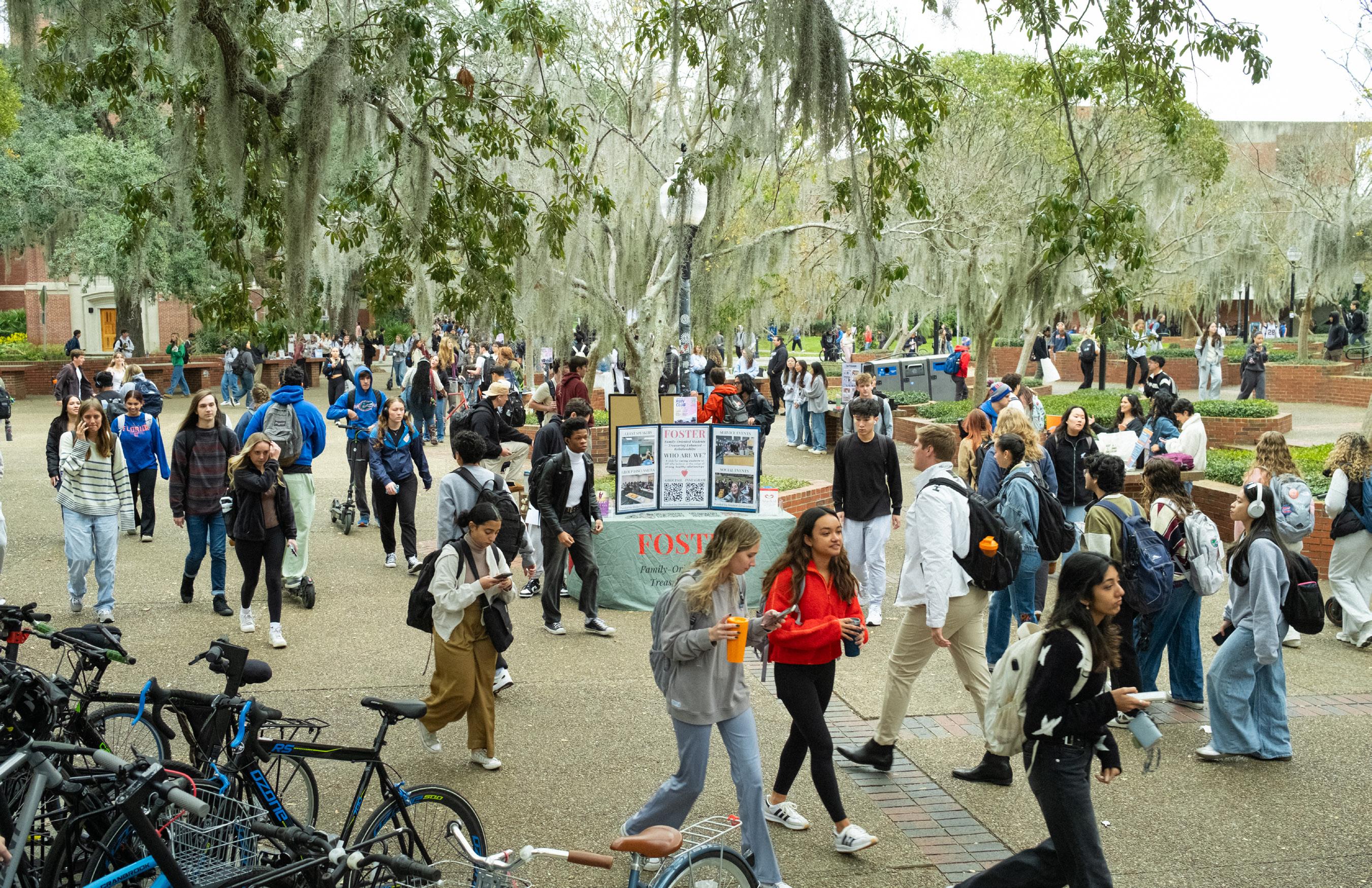ENGINEERING SCHOOL OF SUSTAINABLE INFRASTRUCTURE & ENVIRONMENT

INTO SUSTAINABLE ENGINEERING | 2025

PUSHING

ENGINEERING SCHOOL OF SUSTAINABLE INFRASTRUCTURE & ENVIRONMENT

INTO SUSTAINABLE ENGINEERING | 2025

PUSHING

On behalf of the Engineering School of Sustainable Infrastructure & Environment (ESSIE), It’s my privilege to share that I will serve as interim director as Kirk Hatfield, Ph.D., steps down after 13 years of leadership. Embarking on this new position, I’d like to mention major updates and accomplishments from the 2024-2025 academic year.
As ESSIE director for 13 years, Hatfield served as a support system to his colleagues, staff, faculty and students. Through his tenure, he contributed greatly to the outstanding success of ESSIE. His achievements include overseeing the hiring of an incredible group of young faculty, aggressively pursuing growth opportunities, curating a uniquely supportive and collegial environment and keeping student experience as his highest priority. He will remain a civil and coastal engineering professor, an insightful educator and role model. I’d also like to bid farewell and congratulate former Interim Dean Forrest Masters, Ph.D., who leaves the University of Florida to serve as the Kearney Dean of Engineering at Oregon State University. I’ve had the pleasure of working with Masters since 1997, and I look forward to tracking the success of this lifelong

This year, ESSIE faculty continue to impact the world through their research, directing national recognition of their expertise toward problem solving. In this issue we spotlight a few ESSIE researchers who are making a difference, from infrastructure around the world to the future of robotic technology and student training, to global health.
David O. Prevatt, Ph.D., is serving in Washington, D.C., as a Jefferson Science Fellow with the U.S. Department of State, focusing on climate resilience in more than 280 U.S.-owned
We explore the research of Eric Du, Ph.D., who is integrating robotics and advanced technologies into classrooms and research, exploring applications across space, the
We touch base with another internationally known UF researcher, Antar Jutla, Ph.D., who is developing a disease-prediction system in the the Gulf of Mexico similar to his cholera risk dashboard that has been implemented in over 20 countries.
Our students also continue to shine. UF remains the only school to win both ASCE flagship national competitions—Steel Bridge and Concrete Canoe—in the same year, first in 2015, again in 2021 and 2024, and now in 2025. Concrete Canoe has won four of the last six championships, while 2025 marks the fifth consecutive Steel Bridge national title. Adding to these accomplishments, UF took first place overall at the ASCE Southeast Regional in Athens, Georgia, demonstrating excellence across all areas of civil engineering. These achievements reflect the strength of our academic programs, the commitment of faculty and advisors, and the passion of our students, with support from alumni and donors playing a vital role.
Still not impressed? UF also earned first place overall at the ASCE Southeast Regional event in Athens, Georgia, showcasing skills in all facets of civil engineering. Our students continue to prove they are among the very best in the country (and world). These results reflect the strength of our academic programs, our focus on experiential learning, the dedication of our faculty advisors and students, and our commitment to developing industry-ready engineers. Of course, the support from our alumni and other donors is gratefully acknowledged and encouraged.
Lastly, we celebrate alumni whose community service and unwavering support for their alma mater has landed them on the esteemed 40 Gators Under 40 list. Here, they reflect on their careers and impact as engineers after graduating from UF.
As I head into the new academic year as interim director, I will continue Hatfield’s commitment to support and celebrate ESSIE faculty, staff, students and alumni. I wish you all the best.
See you soon, and Go Gators!
Kurtis Gurley, Ph.D.
Interim Director
$ 20.6M $ 20.3M 168
Antar Jutla, Ph.D., plans to expand his cholerarisk dashboard to the Florida's Gulf Coast to fight dangerous bacteria.
Our Eckhoff Steel Bridge and Concrete Canoe teams win overall at this years ASCE Southeast Student Symposium securing their 3rd consecutive win!
Stay informed with the latest advancements from the Center for Coastal Solutions.
The UF Transportation Institute is paving the way for future mobility with innovative research and cuttingedge solutions.
By Dave Schlenker
The American Society of Civil Engineers (ASCE) has inducted three faculty members from the Herbert Wertheim College of Engineering at the University of Florida as ASCE Fellows: Lily Elefteriadou, Ph.D., Kyle Riding, Ph.D. and Scott S. Washburn, Ph.D.. The professors are now among the 3% of ASCE members who are Fellows and are among nine ASCE Fellows at UF. To be selected as an ASCE Fellow, candidates must have served a minimum of 10 years as a member of the organization and hold a Professional Engineer (P.E.) license.
Elefteriadou is the former director of the UF Transportation Institute (UFTI) and the Barbara Goldsby Professor of Civil Engineering. Her research areas are traffic management, traffic simulation and advanced technologies in transportation, and she has contributed to numerous federal and state projects on congestion mitigation. She also has written about 200 publications and the textbook, “Introduction to Traffic Flow Theory.”
She has served as chair of the Transportation Research Board’s Highway Capacity and Quality of Service Committee. She also served on the Executive Board of the Council of University Transportation Centers and was the 2014-2015 president of the ARTBA Research and Education Council.
Elefteriadou also created the I-STREET Living Lab, an open-road testing facility for UF and the city of Gainesville to innovate solutions to transportation mobility and safety. Its success is recognized by the Florida Department of Transportation (FDOT) and gained $10 million in funding to continue research and education to advance new technologies alongside transportation companies.

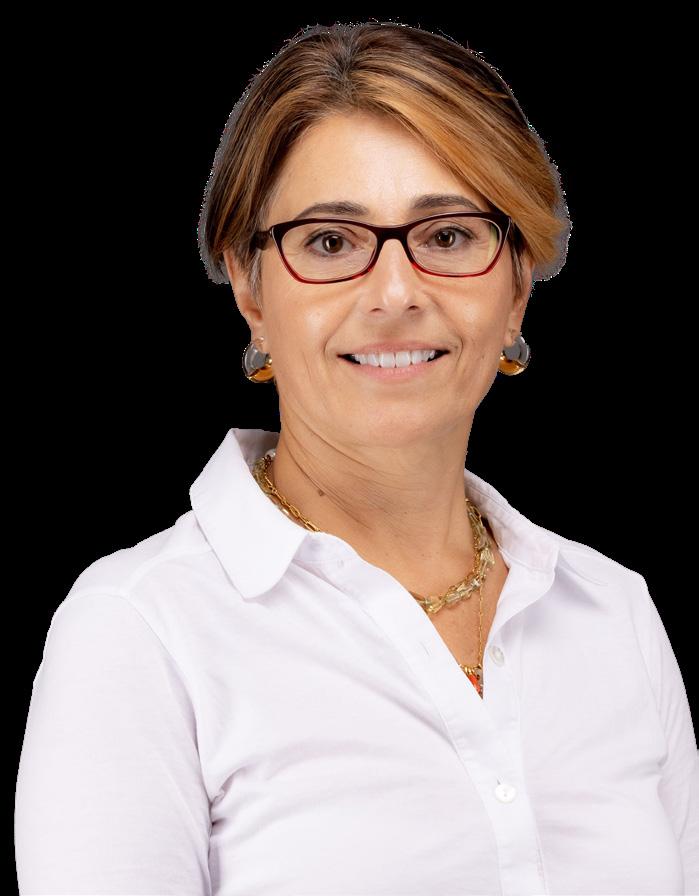
Riding is a professor and department head of Civil & Coastal Engineering, as well as interim director of UF’s Transportation Institute.
Before coming to UF, Riding was on the faculty at Kansas State University for eight years. He received his bachelor’s degree in civil & environmental engineering from Brigham Young University in 2002 and his master’s degree and Ph.D. from the University of Texas at Austin in Civil Engineering in 2004 and 2007, respectively. His expertise is in concrete material science, concrete construction and concrete structural repair.
He is a recognized expert in alternative supplementary cementitious materials, early-age concrete properties, concrete durability and mass concrete construction. He is a chair of the American Concrete Institute committee 231 Properties of Concrete at Early Ages and is a voting member of ACI committees 201 Durability of Concrete, 207 Mass and Thermally Controlled Concrete, 236 Material Science of Concrete and 318A Structural Concrete Building Code General, Concrete and Construction.
He served as chair of the Precast/ Prestressed Concrete Institute Concrete Materials Technology Committee from 2016-2025 and as chair of the American Ceramic Society Cements Division from 2013-2014. He is a member of the ASCE Committee on Concrete Canoe Competitions. He received the Wason Medal for Materials Research from the American Concrete institute in 2011 and 2023, and the Young Member Award for Professional Development in 2013. He is a fellow of ACI and the American Society of Civil Engineers, as well as a registered professional engineer in Florida, Kansas and Nebraska.
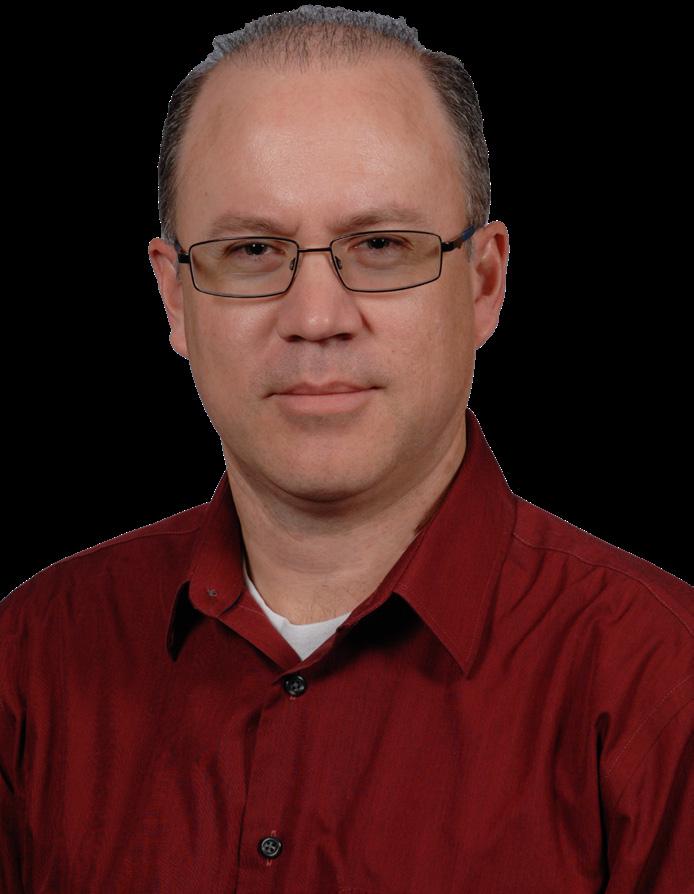
Washburn, a professor with UF’s Department of Civil & Coastal Engineering, was honored for decades of leadership and outstanding contributions to civil engineering.
Also a transportation engineer, Washburn has served more than 25 years as a professor, teaching nearly 1,500 undergraduate and graduate students. Washburn has been a co-author of the textbook “Principles of Highway Engineering and Traffic Analysis,” which has sold more than 45,000 copies since 2004 and is used at more than 140 universities.
“It is a great honor to be recognized with the Fellow status by ASCE, an organization that has had an incredible impact on society and the profession of civil engineering over its long and rich history,” he said.
Washburn has made a significant impact in the transportation profession, primarily in the areas of traffic operations analysis and simulation modeling.
Washburn is also co-author of a popular textbook on highway engineering and traffic analysis – “Principles of Highway Engineering and Traffic Analysis, 7th Edition.”
“The textbook is the No. 1 selling book in its market—more than 45,000 copies have been sold since 2004 and it has been adopted by instructors at over 140 different colleges/universities worldwide,” Washburn said earlier this year.
As a researcher, Washburn has been a trailblazer in traffic analysis and has made important contributions that have been included in the Highway Capacity Manual.
By Reba Liddy
Members of the American Society for Engineering Education (ASEE) elected Elliot Douglas, Ph.D., a professor and department head of Environmental Engineering Sciences, as vice president of finance. He’ll serve a two-year term that began in June 2025, during which he will lead the finance committee and work with ASEE finance staff to provide oversight and develop strategic direction for the society’s finances.
Douglas credits the ASEE for being a key factor in his professional life. He said the organization was a major support system early in his career and carries the torch by being an active and contributing member to the ASEE. In 2021, he was inducted as an ASEE Fellow. Douglas has also been recognized by winning the Outstanding Teaching Award for the ASEE Southeastern Section in 2013 and the Distinguished Service Award for the Educational and Research Methods Division in 2018.
The ASEE was founded in 1893 and is committed to fostering community, education, and services in engineering and engineering technology. The organization’s efforts push its mission to provide professional opportunities and programs for engineering faculty members and students. Today, the ASEE has over 8,000 members and is affiliated with 400 colleges and universities and over 50 corporations. Members of the ASEE consist of deans, department heads, faculty, students, and even government and industry representatives.

ELLIOT DOUGLAS, PH.D. PROFESSOR

By Dave Schlenker
Armed with a $7 million grant from the Army Corp of Engineers, University of Florida researchers are working to bolster shoreline resilience and restore troubled wetlands in St. Augustine through nature-based solutions.
“The idea of nature-based solutions is to build what we sometimes refer to as green infrastructure, to use living, natural components as the building blocks,” said Andrew Altieri, Ph.D., an assistant professor and interim director of the Center for Coastal Solutions, also known as CCS.
Instead of building man-made structures to protect wetlands, for example, restoration crews can move dredged natural sediment otherwise destined for costly disposal to increase wetlands’ size and elevation, restoring their ability to protect shorelines from storm surge, keep pace with sea-level change, filter toxins, store carbon and provide habitats for wildlife.
The project is in concert with the Army Corps of Engineers’ goal to naturally reuse and repurpose at least 70% of dredged sediment into other natural areas to benefit habitats and restoration by 2030.
“It is critical to understand, test and model how natural processes can be harnessed and strategically implemented to sustainably meet the challenge of rapidly intensifying coastal hazards while also providing environmental, economic and social benefits,” Altieri wrote in the project’s technical summary.
Overall, the multi-disciplinary project closely examines patterns and processes of change in coastal landscapes. That includes wetlands — marshes and mangroves — and beach/dune systems.
The project comes as these coastal areas are facing threats both natural and human. These areas are essential to wildlife, air quality, native vegetation, storm protection and the overall health of the ecosystem. A 2008 study by the U.S. Fish and Wildlife Service reported a net loss of about 361,000 acres of wetlands in the coastal watersheds of the eastern United States between 1998 and 2004 — an average net decrease of 59,000 acres each year, with experts citing sea-level rise as one of the primary factors.
“We're trying to understand the patterns of that loss and what's leading to it,” Altieri said. “These systems are essentially the first and sometimes last line of defense against coastal hazards, risks that include storm surges and coastal flooding. They are forming a buffer, this kind of protective layer on our coast. But they're changing, generally for the worse and are in danger of being lost.”
With this project, the CCS-led research team plans to advance the science, technology and engineering principles of nature-based solutions.
With marshes, the primary concern is elevation loss, which can drown the vegetation critical to the ecosystem. They are sinking, eroding and succumbing to sea-level changes, Altieri said.
“The plants are really important for trapping sediment and holding sediment,” he said. “You lose some of the plants, then you get more erosional loss and a lack of the accumulation of sediment.”
Sediment is natural muck on the bottom of water bodies.
“If we can add sufficient sediment to increase the elevation to a
level where the plants thrive, then they will retain that sediment that's been added to hopefully trap more sediment and accumulate more biomass through their growth,” Altieri said. “It’s something that may need to be done periodically. You may stop that decline, but you may even reverse the process of loss and change the trajectory.”
As a bonus, this process saves the cost of disposing of dredged sediment, which is usually piped offshore or to a materials-management area.
This project is the next step for CCS-led coastal resilience efforts in St. Augustine. In 2024, CCS and WSP Environment & Infrastructure Inc. launched a coastal wetlandsrestoration project to keep pace with sea level change and erosion. The 2025 work is a standalone project with separate funding, Altieri said.
Researching the resilience of dunes comes with a different set of dynamics. Here, they are looking at the plants that support the dunes – sea oats and panic grass, for example. That vegetation also provides a habitat for animals such as beach mice, turtles and birds.
On the beach, the team also is looking at water energy and how grain size affects the stability of dunes.
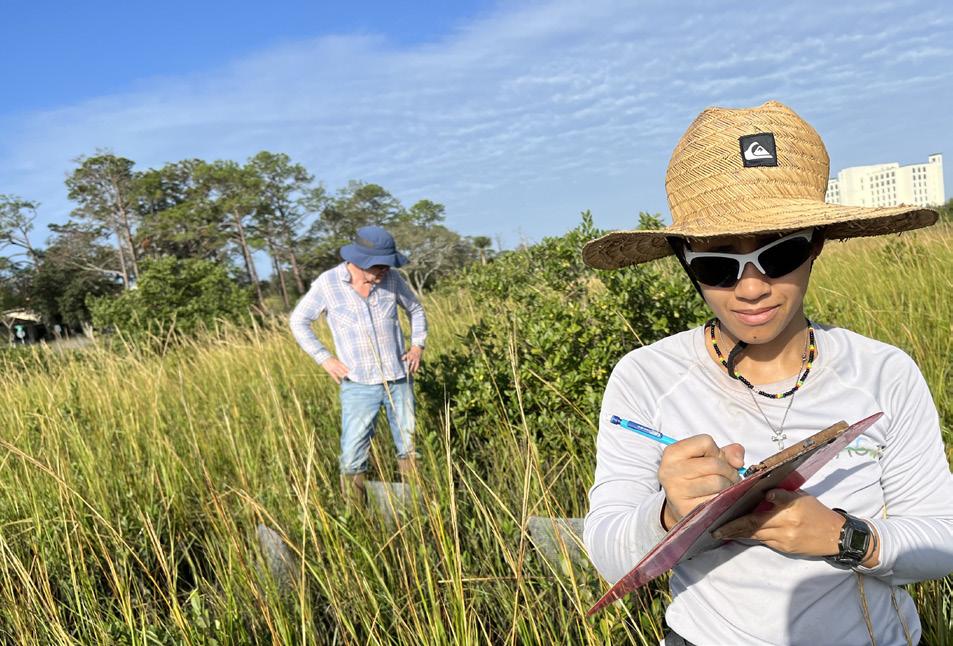
The current project also has more research disciplines and project partners, including UF researchers from Landscape Architecture, Geological Sciences and the School of Forest, Fisheries and Geomatic Sciences.
“Storm surges, wave energy, coastal flooding – all of that can be slowed or reduced because of wetlands,” Altieri said. “They are basically like shock absorbers. These wetlands, beaches and dunes can be lost or eroded to some degree, but the upland area behind them is essentially protected.”

ERIC DU, PH.D., PROFESSOR
“It’s understanding water movement, water energy. How is that interacting with depositing sediment, moving sediment around, sorting sediment? With water, you tend to carry finer particles further than coarser materials,” he said.
What does success look like after the award’s five years end?
“We'll have an understanding of what's changing on our coasts and why,” Altieri said. “We'll have an understanding of how we can work within this system to modify the natural components and utilize the natural processes. And we will hopefully be working with partners through additional funding mechanisms to actually apply that towards implementation of solutions to increase coastal resilience.”
The team also includes Peter Adams, Department of Geological Sciences; Julie Bruck, Department of Landscape Architecture, School of Landscape Architecture and Planning; Maitane Olabarrieta, ESSIE; Alex Sheremet, ESSIE; Nina Stark, ESSIE; Ben Wilkinson, Geomatics Program, School of Forest, Fisheries, and Geomatics Sciences; and Xiao Yu, ESSIE.
By Reba Liddy
Eric Du, Ph.D., is a civil engineering professor whose research focuses on human-robot collaboration and mixed reality, exploring robotics design to enhance training on how we interact with robots. His work aims to develop AI, augmented reality and virtual reality systems to improve workforce development and safety on construction sites and in healthcare as well as in the ocean and in space.
His research has garnered millions in funding from prestigious organizations including the National Science Foundation, NASA, National Institute of Standards and Technology and the Air Force Office of Scientific Research.
Du has published over 200 peer-reviewed papers featured in highly regarded academic journals and conferences. He serves as director at the Informatics, Cobots and Intelligent Construction Lab and chair of the Visualization, Information Modeling and Simulation Committee under the American Society of Civil Engineers.
ERIC DU, PH.D., Civil Engineering Professor

TIM TOWNSEND, PH.D. Distinguished Professor

XILEI ZHAO, PH.D. Associate Professor
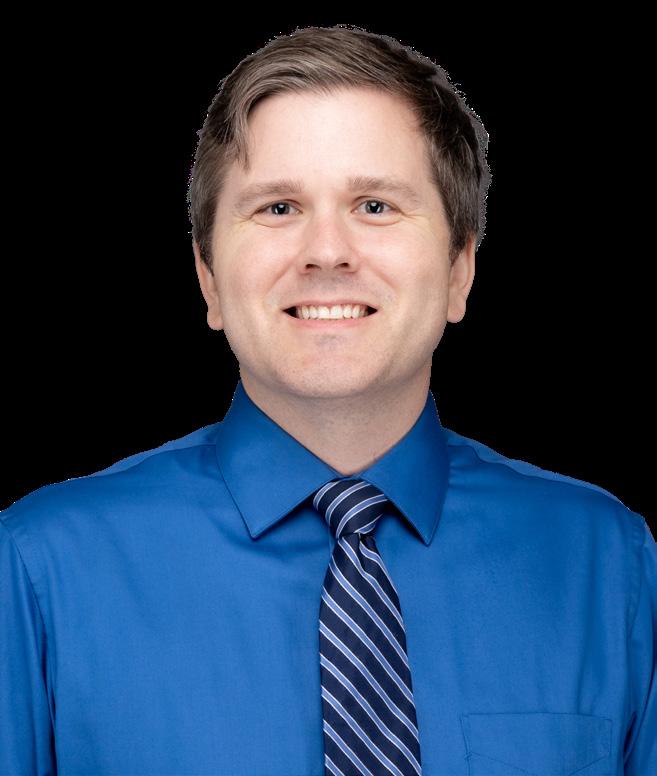
BRIAN PHILLIPS, PH.D. Full Professor

ALTIERI, PH.D. Associate Professor

ANTARPREET JUTLA, PH.D. Full Professor

PH.D. Associate Professor
By Reba Liddy


JOHN SCHMERTMANN, PH.D., EMERITUS PROFESSOR
The Geo-Institute (G-I) of the American Society of Civil Engineers (ASCE) recently named John Schmertmann, Ph.D., a Geo-Legend.
Schmertmann, a retired University of Florida emeritus professor, built a career contributing to geotechnical engineering research, teaching and practice.
The G-I has developed a series of episodes featuring prominent engineers in the geotechnical field. In the Geo-Legend episode highlighting Schmertmann, Bob Bachus, Ph.D., the guest host, said Schmertmann is one of the most highly regarded experts in geotechnical engineering.
Born and raised in New York, Schmertmann first became intrigued by the engineering profession one day while with his father when he was 7 years old. He recalled seeing the Hindenburg fly overhead and being fascinated with how difficult zeppelins were to build. His interest in engineering was further piqued when he took technical science and math classes in high school.
He was destined for greatness when he ranked second in his high school class and was voted as the “Most Likely to Succeed.” During his undergraduate studies at Massachusetts Institute of Technology, Schmertmann enjoyment of his course on engineering geology persuaded him to earn a bachelor’s degree in civil engineering. He continued his education by earning a master’s degree and a Ph.D. in civil engineering at Northwestern University.
After finishing school, he began his engineering career at Rutledge, a consulting firm in New York, working on projects and writing papers. Three years later, he was contacted about the draft.
He initially joined the U.S. Army Reserve for six months but was later put on active duty. Six weeks or so of training went by, and he was made an active sergeant where he led his own platoon, before joining the engineering sector.
“You have to be curious. You’re going to be the future leaders of the profession, you have a responsibility to take the knowledge that you’ve gotten, that you’ve obtained, to explore that and work on it and to work to improve it, that’s a responsibility,” Schmertmann said.
He moved to Gainesville, Florida, with his wife, Pauline, and children and started his journey as a civil engineering assistant professor at UF. From 1956 to 1978, he was promoted to associate professor and professor, before retiring in 1979.
During his career, Schmertmann joined multiple organizations such as ASCE, the American Society for Testing and Materials, the Florida Engineering Society, and the National Academy of Engineering.
He is nationally recognized for his contributions to geotechnical engineering. He published over 75 technical papers. He became one of the early pioneers of energy measurements, winning the Middlebrooks Award in 1981. He developed design methods used around the world, introduced new soil aging concepts and testing methods for piping through embankment sands, and contributed to deeper thought on clay shear strength and consolidation.
His contributions to civil engineering have earned him top ASCE honors, including the State of the Art in Civil Engineering Award, Middlebrooks Award, Collingwood Prize, Norman Medal twice and a Lifetime Achievement Award. ASCE named him a Hero, and in 2008, published a book in his honor.
With over 55 years of experience, Schmertmann decided to develop his consulting business, John H. Schmertmann Inc. Among the over 500 geotechnical problems he solved, two projects he believes he enjoyed most were the relocation of the NASA crawlerways and Cape Hatteras Lighthouse.
Today, at the age of 96, Schmertmann enjoys retirement in Gainesville with Pauline, and their four adult children, Carl, Gary, Neil and Joy, who pursued similar professions to him.
By Reba Liddy

Xiang “Jacob” Yan, Ph.D., an assistant professor in the Department of Civil and Coastal Engineering, is trying to make public transit more appealing to passengers and potential users.
Traditional approaches for bus stop amenities assessment often rely on manual surveys of each stop, which can be labor intensive. Instead, Yan and his research team developed a transit amenities assessment system (TAAS), which uses computers and artificial intelligence to quickly collect data for the public transit systems. The TAAS model integrates YOLOv8, a model great for identifying and pinpointing objects in real-time, along with a dynamic prediction algorithm and transfer learning to classify and segment Google Street View images.
“Transit agencies can use this system to create comprehensive, up-to-date inventories of bus stop amenities, enabling them to identify and prioritize necessary improvements. In fact, our ongoing research project aims to use the system to develop a nationwide transit stop amenities database," Yan added.
underserved,” Yan said. “Cities can use this data to identify gaps in amenity provision at transit stops and prioritize improvements in underserved areas, particularly in neighborhoods with high transit dependency or vulnerable populations.”
In this initial study, Yan and the team selected five cities in Florida: Gainesville, Jacksonville, Miami, Orlando and Tampa. Google Street View images from each bus stop were used to ensure the accuracy, efficiency, and cost-effectiveness of bus stop amenities assessment.
“The system can be deployed across different urban contexts with relatively low additional cost and effort, making it a practical solution for large-scale assessments of bus stop amenities,” Yan said. Beyond low-cost improvements, he said this effort is important because these “amenities make waiting safer and more comfortable, which can encourage people to use buses more.”
These disparities highlight inequities in transit infrastructure planning, where certain areas – particularly those with lower ridership – may be underserved.
Identifying the gaps in transit planning is crucial for a community’s population when they access public transportation, especially in major cities. The study, funded by the Center for Transit-Oriented Communities (CETOC), aims to build a structured system, picking up where previous data collections have left off. This approach focuses on amenities like shelters, seating, signage, lighting, and accessibility features at bus stops.
“These disparities highlight inequities in transit infrastructure planning, where certain areas – particularly those with lower ridership – may be
Yan is confident in his findings and knows that the automated assessment system will continue to identify other amenities such as trash bins, paved boarding areas, crosswalks, and pedestrian-level lighting to improve transit infrastructure projects.
After his research is completed, he believes that transit agency staff and transit advocates across cities can integrate the system to create comprehensive, up-to-date inventories of bus stop amenities to prioritize necessary improvements.
Yan and the research team plan to develop a nationwide transit stop amenities database through CETOC funding.

By Dave Schlenker
By Emily Hinds
Drifting silently in the cramped quarters of a spacecraft millions of miles from Earth, an astronaut clutches their side, wincing at a sudden, unfamiliar pain. There’s no doctor onboard, no emergency room to rush to — only isolation and the ticking clock of a medical crisis in space. Scenarios like this are exactly what Eric Du, Ph.D., and his team are working to address.
While space research often brings up images of distant worlds and cosmic phenomena, Du is focused on a more immediate challenge: safeguarding astronaut health. As NASA and other space agencies prepare for extended missions to the moon and Mars, the ability to diagnose and treat medical issues remotely, including procedures like ultrasounds, is no longer a distant ideal, but a vital necessity for life beyond Earth.
Du’s research, supported by NASA, is focused on making sure they don’t have to wait that long to act.
Du, a professor in the Herbert Wertheim College of Engineering and a member of the Astraeus Space Institute at the University of Florida, is developing new ways for astronauts to control robotic hands — even when communication delays make real-time operation impossible. His work was recently featured in a BBC Future article examining why robotic hands remain one of the biggest technical hurdles in robotics.
“Human hands are incredibly sensitive and flexible,” Du told the BBC. “Replicating that ability in machines, and then allowing humans to intuitively control them under delay, is a huge challenge.”
To address it, Du and his team are combining embodied artificial intelligence — systems that learn motor skills by physically interacting with the environment — with sensory manipulation techniques like haptic feedback. By enabling both AI systems and human operators to "feel" what the robot hand is touching through vibrations or pressure cues, this approach effectively mimics the sense of touch that is critical for delicate tasks like medical procedures. It also provides a more intuitive control interface for human operators, especially in situations where visual or auditory feedback may be delayed or disrupted.
The goal is not only to improve task performance but also to reduce the cognitive burden on the human operator. In space, where stress levels are already high and errors can be costly, intuitive robotic systems could make a life-saving difference.
This research is helping lay the groundwork for the future of space medicine, a field that is rapidly gaining importance. If astronauts are going to spend months or years in deep space, they’ll need tools to conduct medical diagnostics and procedures independently. Du’s work suggests that procedures like ultrasounds could one day be safely performed by astronauts using robotic systems, guided from Earth or aided by onboard AI.
These innovations also have potential applications on Earth, from rural telemedicine to emergency response in hazardous environments. By improving the way humans and robots interact under delay, Du’s work is expanding access to care — no matter where the patient is located.
“We’re not just building machines,” Du said. “We’re building tools that extend human ability, in space and on Earth.”
Du's work is part of a broader initiative at UF to develop space-ready technologies with real-world impact. The Astraeus Space Institute brings together faculty across disciplines to solve the practical challenges of human spaceflight, from robotics and AI to life sciences and policy.
“Over the next five to 10 years, I envision our technology becoming a game-changer for astronauts, beginning with training. Robotic hands will first serve as a training tool, allowing astronauts to practice medical procedures in simulated space conditions, such as microgravity or delayed communication, so they can handle real emergencies with confidence,” Du said. “Looking ahead, robotic hands capable of performing precise medical tasks will empower astronauts to maintain their health autonomously, reducing risks and making extended stays on Mars or lunar bases more viable.”
As humans prepare to go farther than ever before, Du’s research ensures we won’t have to leave our ability to care for each other behind.
By Dave Schlenker

After deploying life-saving cholera-prediction systems in Africa and Asia, a University of Florida researcher is turning his attention to the pathogen-plagued waters off Florida’s Gulf Coast.
In the fight to end cholera deaths by 2030 – a goal set by the World Health Organization – UF researcher and professor Antar Jutla, Ph.D., has deployed his Cholera Risk Dashboard in about 20 countries, most recently in Kenya. Using NASA and NOAA satellite images and artificial intelligence algorithms, the dashboard is an interactive web interface that pinpoints areas ripe for thriving cholera bacteria.
It can predict cholera risk four weeks out, allowing early and proactive humanitarian efforts, medical preparation and health warnings. Cholera is a bacterial disease spread through contaminated food and water; it causes severe intestinal issues and can be fatal if untreated. The US Centers for Disease Control reports between 21,000 and 143,000 cholera deaths each year globally.
Make no mistake, the Cholera Risk Dashboard saves lives, existing users contend.
His team now wants to set up a similar pathogen-monitoring and disease-prediction system for pathogenic bacteria in the warm, pathogen-fertile waters of the Gulf of Mexico.
Its timeliness, its predictiveness and its ease of access to the right data is a game changer in responding to outbreaks and preventing potentially catastrophic occurrences.

- Linet Kwamboka Nyang'au, senior program manager for Global Partnership for Sustainable Development Data
Jutla is seeking funding to develop a pathogen-prediction model to identify dangerous bacteria in the Gulf to warn people – particularly rescue workers – to use protective gear or avoid contaminated areas. He envisions post-hurricane systems for the Gulf that will help the U.S. Navy/Coast Guard and other rescue workers make informed health decisions before entering the water.
And he wants UF to be at the forefront of this technology.
“If we have enough resources, I think within a year we should have a prototype ready for the Gulf,” said Jutla, an associate professor with UF’s Engineering School Sustainable Infrastructure and Environment. “We want to build that expertise here at UF for the entire Gulf of America.”
Jutla and his co-investigators have applied for a five-year, $4 million NOAA RESTORE grant to study pathogens known as vibrios off Florida’s West Coast and develop the Vibrio Warning System.
These vibrios in the Gulf can cause diarrhea, stomach cramps, nausea, vomiting, fever and chills. One alarming example is Vibrio vulnificus, commonly known as flesh-eating bacteria, a bacterium that often leads to amputations or death.
The Centers for Disease Control and Prevention (CDC) has reported increases in vibrio infections in the Gulf region, particularly from 2000 to 2018. The warm and ecologically sensitive Gulf waters provide a thriving habitat for harmful pathogens.
“The grant builds directly on the success of our cholera-prediction system," Jutla noted. "By integrating AI technologies into public health decision-making, we would not only lead the nation but also become self-reliant in understanding the movement of environmentally sensitive pathogens, positioning ourselves as global leaders.”
Jutla’s dashboards are critical tools for global health and humanitarian officials, said Linet Kwamboka Nyang’au, a senior program manager for Global Partnership for Sustainable Development Data.
“Its timeliness, its predictiveness and its ease of access to the right data is a game changer in responding to outbreaks and preventing potentially catastrophic occurrences,” Kwamboka Nyang’au said.
Over the last few years, Jutla and several health/government leaders have been working to deploy the cholera-predictive dashboard.
“Our partnership with UF, the government of Kenya and others on the cholera dashboard is a life-saving mission for high-risk, extremely vulnerable populations in Africa. By predicting potential cholera outbreaks and coordinating multi-stakeholder interventions, we are enabling swift action and empowering local governments and communities to prevent crises before they unfold,” said Davis Adieno, senior director of programs for the Global Partnership for Sustainable Development Data.
The early warnings for waterborne pathogens also allows the United Nations time to issue early assistance to residents in the outbreak’s path, said Juan Chaves-Gonzalez, a program advisor with the United Nations’ Office for the Coordination of Humanitarian Affairs.
“There are several things we do with the money ahead of time. We provide hygiene kits. We repair and protect water sources. We start chlorination, we set up hand-washing stations, train and deploy
rapid-response teams. At the community level, we try to inject funding to procure rapid-diagnostic tests,” he said.
“We identify those very, very specific barriers and put money in organizations’ hands in advance to remove those barriers.”
In the United States, hurricanes stir up vibrios in the Gulf, posing a high risk of infection for humans in the water. There has been a nearly 200% increase in these cases over the last 20 years in the U.S., according to the CDC.
“After Hurricane Ian, we saw a very heavy presence of these vibrios in Sarasota Bay and the Charlotte Bay region. Not only that, but they were showing signs of antibiotic-resistance. Last year, we had one of the largest number of cases of vibriosis in the history of Florida,” Jutla said.
Samples from 2024 hurricanes Helene and Milton are being analyzed with AI and complex bioinformatics algorithms.
“If there is a risky operation by rescue personnel, not using personal protective equipment, then we would want them to know there is a significant concentration of these bacteria in the water,” Jutla said. “As an example, Navy divers operating in contaminated waters are at risk of infections from vibrios and other enteric pathogens, which can cause severe gastrointestinal and wound infections.”
“Exposure to vibrios and other enteric pathogens,” Jutla added, “can disrupt economic activities, particularly in coastal regions that are dependent on tourism and fishing. And vibrios may be considered potential bioterrorism agents due to their ability to cause widespread illness and panic.”

In developing the Vibrio Warning System, Jutla noted, he and his team want to significantly enhance public health safety and preparedness along the Gulf Coast. By leveraging advanced AI technologies, satellite datasets and predictive modeling, they plan to mitigate the risks posed by environmentally sensitive pathogenic bacteria, ensuring timely interventions and safeguarding human health and economic activities.
“Hospital systems and healthcare providers in the Gulf region will have a tool for anticipatory decision making on where and when to anticipate illness from these environmentally sensitive vibrios, and issue a potential warning to the general public,” he said. “With the potential to become a leader in environmental pathogen prediction, UF stands at the forefront of this critical research, poised to make a lasting impact on local, regional, national and global health and safety.”

By Reba Liddy
Whether they are automating repairs for NASA’s International Space Station, enhancing autonomous drone systems for the U.S. Air Force, or advancing teleoperated ultrasound technology for emergency care, University of Florida civil engineering students are at the forefront
of innovation in robotics. Under the guidance of Eric Du, Ph.D., a UF civil engineering professor, students are using advanced applications of ground robots, robotic arms, and drones to develop cutting-edge solutions with real-world impact.
“Through our extensive research into teleoperation technologies, we utilize robots, autonomous drones, and industrial manipulators to push the boundaries of robotic capabilities,” Du said. "Our students gain a comprehensive set of skills ranging from the technical aspects of robotics, such as programming and system design, to critical soft skills like problem solving and interdisciplinary collaboration. This approach prepares them to master the technical details and understand the broader implications of robotics in real-world applications."
Through NASA’s funding efforts, Du’s lab uses robotics to focus on automating repair and replacement for the Artemis program, which is focused on moon exploration. The goal for the program is to build
a permanent base on the moon to support eventual missions to Mars.
Robotic repairs are crucial for long-term space missions and help construct habitats in outer space.
Du’s lab is especially focused on addressing the challenges of lunar communication delays in teleoperations. According to NASA, the current lunar communication delay can range from five to 14 seconds, which is a stark difference from that of the Earth orbit (2.6 seconds).
“Our systems integrate a high-fidelity physics simulator to generate simulated physical feedback, such as momentum and impact, in real time before actual signals are received,” Du said. “This simulated synthetic physical feedback enhances the operators’ sense of presence and creates the perception of shorter delays than are actually experienced.”
The lab developed a sensory manipulation system that mimics real-world physics to ensure robots function reliably in extremeenvironmental conditions in outer space. This allows Earth-based operators to feel what is happening with the robot in real time, even with communication delays.

Students in Du’s lab work with technology that is tailored to challenging environments. Given Florida’s susceptibility to natural disasters like hurricanes, robotics play a key role in data collection, emergency response, and disaster recovery. Du and his lab researchers worked to improve emergency response times by deploying robotic dogs in conditions that would be considered unsafe for humans. The robotic dogs were able to scan and assess the environment to troubleshoot the safest outcome.
Yangming Shi, Ph.D., a 2020 UF alum and current assistant professor of civil engineering and robotics at the Colorado School of Mines, said Du's guidance helped shape his holistic approach to research.
“He pushed us to think not just about the technical aspects of robotics but also about the broader societal impact. He challenged us to come up with solutions that can address real-world challenges, like extreme weather events and infrastructure vulnerabilities,” said Shi, who pursued his civil engineering doctoral degree in Du’s lab. “His mentorship has shown me the importance of marrying technical prowess with social responsibility in our research works.”
Du and his lab researchers also understand that robots have to be trained in certain environments to be effective. This reality became evident when Gilbert Yang Ye, Ph.D., a recent UF graduate and assistant professor of civil engineering at Northeastern University, had to fully train a robot in Du’s lab to perform an unfamiliar task — dexterously installing pipes for waste treatment and data collection.
“I was astonished by the gaps we face and the potential change robotic technology can make. This was the moment when I started looking at robotic technology for environmental and climate issues,” Ye said. “After leaving UF, I found that other domains also share similar bottlenecks, such as network stability and latency issues in remote medical tasks. So, my research now expands to teleoperated robots for remote medical examination, such as ultrasonic diagnosis.”
Du encourages his students to adopt a multidisciplinary approach in their robotics applications, particularly in areas like healthcare.
"We work with medical professionals from the departments of emergency medicine and anesthesiology to analyze human motor skills during medical procedures and translate these skills to robotic operations,” Du said. “This interdisciplinary engagement allows students to see firsthand how robotics can enhance precision and efficiency in healthcare.”
The lab collaborates with psychology researchers to explore cognitive robotics, studying how robots can simulate human decision-making processes. This approach advances robotics while providing students with an understanding of the intersection



between technology and human behavior, enhancing their ability to address complex challenges.
Additionally, the lab focuses on bilateral control systems for remote robots addressing critical needs in telehealth, such as improving the accuracy of ultrasound procedures during emergency medical interventions. By integrating these technologies, the lab showcases the diverse potential of robotics to transform industries ranging from disaster response to healthcare improvements.
“[Du’s] mentorship has shaped my understanding of how robotics and other emerging technologies can be applied, not only to improve efficiency and safety on construction sites but also to address larger societal challenges such as climate resilience and sustainability,” Shi said. “As a result, my career goal is to contribute to the development of autonomous systems that bridge the gap between technological innovation and real-world applications, particularly in infrastructure and disaster recovery.”
ABIRAL AASHISH
· Won the Best Paper Award, Freeway Operations Committee
ELIANA DUARTE
· Earned the National Science Foundation GRFP Fellowship
RENAN FAVERO
· Won Daniel Fambro Student Paper Award, ITE 2025 International Annual Meeting
BRYCE GRAME
· Won The 3-Minute Pitch Student Competition, ITE 2025 International Annual Meeting
KAZI TAHSINA HABIB
· Received the Dale Lundgren Air Resources Scholarship
FABIOLA Y. RODRIGUEZ
· Recieved CDM Smith Award
· Recieved the Florida Awra Storch Graduate Award
· Received the 2025 Summer Travel Award - Water Institute
· Recieved the Evergreen Surety Bond Scholarship Award from the Environmental Research and Foundation’s Scholarship Program
SANNERI E. SANTIAGO BORRES
· Earned the Association for Academic Women’s Honorable Mention Award
· Won second place for her Poster at the Essie Poster Symposium
· Served as a U.S. Department Of Energy Scholars Intern in the Office of Assistant Manager for Infrastructure and Environmental Stewardship
MILEISHA L. VELAZQUEZ -LÓPEZ
· Received the Sally And William Glick Graduate Research Endowment
· Received the Awra Florida, William V. Storch Student Award
· Accepted into the Secasc’s Global Change Research Fellows Program
· Won the UF Water Institute’s 2024 Photography Contest
· Received the Florida Sector American Water Works Association’s Roy Linkins Scholarship
· Received HT Odum Scholarship Award
ELIZABETH VOLPE
· NSF Early Career Award
· Published two Peer-Reviewed Journal Articles and two Conference Papers
· Obtained Microcredentials in AI and Generative AI Prompting
GUSTAVO ZSCHABER
· Won the 3-Minute Pitch Student Competition at the ITE 2025 International Annual Meeting
UF ASCE TEAM
· First Place, Audrey Traffic Control Competition Team: Lance Chen, Michael England, Kyle Groom and Thomas Raffenberg
UF ITE
· First Place, Florida-Puerto Rico District Traffic Bowl Team: Sanidhya Dadia and Michael Panarisi
· First Place, International Collegiate Traffic Bowl Team: Sanidhya Dadia, Fazur Himel, and Michael Panarisi
ENVIRONMENTAL ENGINEERING DESIGN 2 – MATERIALS MANAGEMENT TEAM
· First Place and Best Presentation, Solid Waste Association 2025 Student Design Competition Team: Sophie Brecko, Shane Borenius, Alex Geer and Rachel Smith
UF ECKHOFF STEEL BRIDGE TEAM
· Overall National Champions, ASCE/AISC Student Steel Bridge Competition
· First Place - Structural Efficiency
· First Place - Stiffness
· Second Place - Lightness
· Second Place - Construction Economy
· Third Place - Cost Estimate
UF CONCRETE CANOE TEAM
· Overall National Champions, ASCE Concrete Canoe Competition
· First Place - Coed Race
· Second Place - Men's Spirit
· Second Place - Best Technical Proposal
· Second Place - Best Technical Presentation
· Fourth Place - Women's Slalom
· Third Place - Women's Sprint
· Fourth Place - Final Product
By Dave Schlenker

Break out more confetti and prepare the already-crowded trophy case. The University of Florida has won another national title.
Less than a month after UF’s Eckhoff Steel Bridge Team made history by capturing its fifth consecutive national title, another UF civil engineering team paddled its way to its fifth national title (four in the last six years).
With a gator-laden vessel dubbed Reptilia, UF’s concrete canoe team narrowly won first overall at last weekend’s 38th annual ASCE Concrete Canoe Competition at California Polytechnic State University at San Luis Obispo. Virginia Tech placed second by less than a point, followed by Western Kentucky University, Texas A&M University and Université Laval.
“The races were quite intense,” said the team’s co-project manager, Alicia DeMicco, a senior majoring in civil engineering. “We were a little nervous.”
Upon hearing they had won, UF team members jumped to their feet at the banquet, screamed, hugged and, of course, did the Gator Chomp.
“We all went crazy,” said the team’s co-project manager, Brennan Kade, a third-year civil engineering student. “I’ll remember that experience forever.”

The American Society of Civil Engineers’ concrete canoe championship ran June 27–29, hosting 19 qualifying schools and more than 180
institutions across North America and China.
UF also scored big in the sub-categories, taking first place in the coed race, second in the men’s sprint, second in best technical proposal and best technical presentation, fourth in the women’s slalom, third in the women’s sprint and fourth in best final product.
“With concrete canoe winning four of the last six national championships and steel bridge securing five consecutive national titles, our students continue to prove that they are among the very best in the country – and the world,” said Taylor Rawlinson, Ph.D., the team’s faculty adviser and director of the Weil Hall Structures & Materials Laboratory.
“These results reflect the strength of our academic program, our focus on experiential learning and our commitment to developing industry-ready engineers.”
Designed, built and powered by UF engineering students from multiple disciplines, Reptilia, Rawlinson said, is fast, efficient and visually stunning. It is covered by a detailed mural accented by glowing gator eyes.
But Reptilia’s most striking feature is the 3D alligator cresting inside the canoe at the paddlers’ feet. Look closely, and you will notice a python wrapped around the gator, a nod toward the delicate struggle between Florida’s native and non-native species.
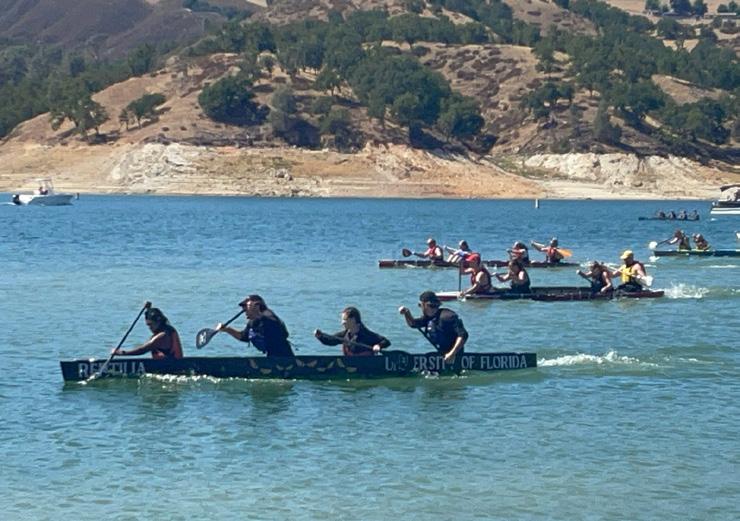
The canoes are made from thin layers of concrete and carbon fiber. Teams must balance the weight of construction materials with performance in the water and turning agility, testing the limits of the materials.
Known as America’s Cup of Civil Engineering, the ASCE competition combines precise engineering, hydrodynamic design and racing technique. America’s Cup also hosts several other engineering events, but the concrete canoes are the flagship competitions.
The 2025 UF concrete canoe team members are Kade, DeMicco, Aiden Kittelson, Keegan Wittke, Grayson Loyless, Senuki Perera, Joel Mass, Thomas Raffenberg, Zelli Pych, Ginger Arnold, Fatima Arroliga, Ashton Dampier, Juliette Holder, Markella Stavrinakis, Matheus Broder, Taylor Nestel, Emily Einheit, Austin Edwards, Carson Edwards, Darius Lee, Emma Baumann, Emily Steyer-Mader, Kyle Keene, Kate Pollard, Mariana Templeton, Maddie Foster, Audrey Hunt, Sophia Maldonado, Gabriella Zweier and Max Milder.
By Megan Sam
Congratulations to Dakota Lewis, recipient of the 2025 Guy Harvey Fellowship! With this support, she’ll be diving deeper into how environmental changes affect fish populations in Florida Bay and predicting how they’ll respond to our changing climate.
“What I love about using fish as a study system is that they can move around,” said Lewis, a fourth-year doctoral candidate at the University of Florida’s School of Natural Resources and the Environment, advised by CCS Interim Director Andrew Altieri, Ph.D. “Unlike organisms that stay in one place, fish can relocate in response to algal blooms or heat-stress events. Their ability to link different ecosystems, and patches within an ecosystem, is fascinating to me.”

Many fish species begin their lives in the seagrass and mangrove habitats of Florida Bay before migrating to coral reefs as they mature. Lewis is studying how fish link Florida Bay to the Florida Keys Reef Tract, and how their communities respond to various disturbances. These disturbances include both negative events, like heat waves, and positive ones, like habitat restoration. They also encompass short-term stressors, such as heat events, and long-term changes like climate change. While some species thrive in these shifting conditions, others struggle. By identifying the “winners” and “losers,” Lewis can pinpoint the most vulnerable species and help shape targeted conservation efforts.
"What impresses me about Dakota is her fearlessness in tackling any challenge by systematically breaking it down into individual objectives then following through with a plan that are for each of those objectives,” said Altieri, assistant professor in the Department of Environmental Engineering Sciences. “She is taking a deep dive into the underlying science to address big conversation and
restoration challenges across multiple ecosystem types.”
The Guy Harvey Fellowship provides Lewis with critical support, including networking opportunities and more resources for her research. After the extreme heat-stress event of 2023, she found it necessary to conduct additional summer sampling that had not been part of her original plan. Funded by the fellowship, this sampling has become another case study of heat stress impacts.

Lewis is grateful for the invaluable support provided by the fellowship, noting its impact on her research and career.
“The Guy Harvey Fellowship does an amazing job of elevating your work and providing opportunities to communicate your research,” said Lewis. “Between the networking and their Florida-focused mission, they go above and beyond in creating connections.”
After graduation, Lewis hopes to lead her own research lab, where she can continue studying fish community dynamics and ecosystem disturbances, and support students.
“I love mentoring the next generation of scientists,” said Lewis. “Our oceans provide essential ecosystem services and are crucial to the health of our planet. It will always be important to research, conserve and protect them.”


By Megan Sam
When children see photos of Alexis Jackson wading through muddy wetlands — swarmed by insects, enduring scorching heat and working alongside alligators and snakes — their first question is usually, “Why are you doing this?”
In the spring, at the Florida Museum of Natural History’s Girls Do Science event, which was attended by more than 1,300 visitors, Jackson answered that question, giving Gainesville’s youth a glimpse into the life of a scientist and the passion that drives her work.
“I hope the young girls at this event took away the message that they can do anything,” said Jackson, a graduate student in environmental engineering sciences in the Watershed Ecology Lab, advised by CCS Associate Director David Kaplan, Ph.D. “I explained to them that I’m in this career because I care about the environment and want to protect wetlands, as well as improve how we predict their future conditions. If children have an interest in any science, I want them to know that there’s a world of career opportunities out there for them to pursue.”
“The Girls Do Science event is crucial for young girls interested in science because it provides them with role models like Alexis, who demonstrate that science is not only accessible, but also exciting and impactful,” said Janelle Pena-Jimenez, public relations coordinator at the Florida Museum of Natural History.
Joining Jackson was lab mate Katie Schoenberger, an environmental engineering sciences graduate student who studies Florida’s springs, and Megan Sam, communications specialist at the UF Center for Coastal Solutions. The two led a food web activity to demonstrate how every plant and animal plays a vital role in keeping ecosystems balanced.
The event also sparked new outreach opportunities. After stopping by the team’s table, a parent involved with the National Parent Teacher Association connected with Jackson and invited her to speak at William S. Talbott Elementary School for Earth Day.
“Even if just one kid walks away thinking science is cool, that means I planted a seed and made a difference,” said Jackson. “Speaking with the community is just good for the soul. I always leave feeling accomplished.”


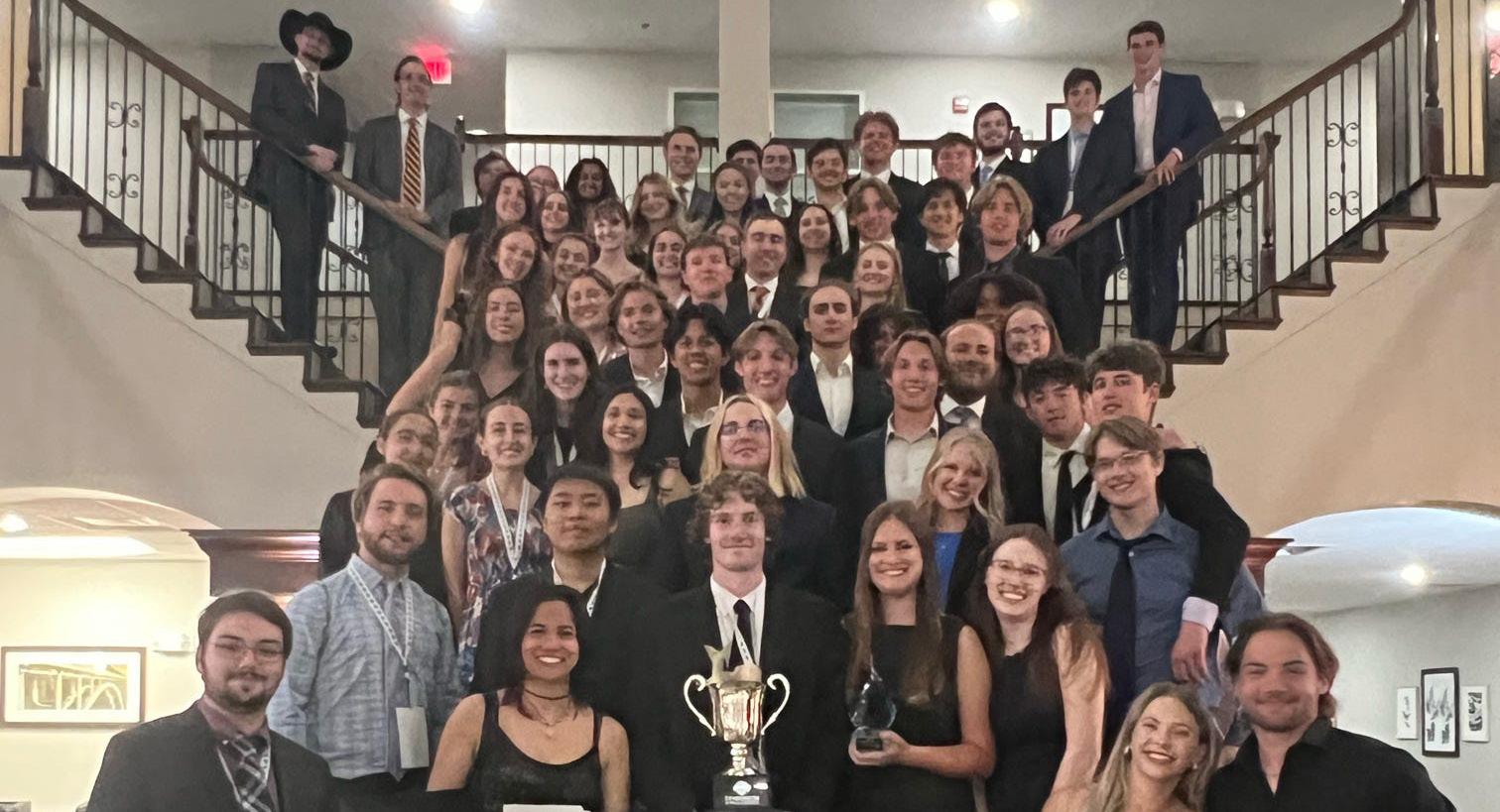
By Dave Schlenker
Championships keep rolling in for University of Florida ASCE chapters, as student teams won first place overall earlier this year at the ASCE Southeast Student Symposium in Athens, Ga.
“UF took first out of 19 universities,” noted ASCE student chapter advisor Mark Newman, Ph.D. “Our students also made more history as the first university in the region to win first place in Steel Bridge, Concrete Canoe, and Overall three years in a row. This means that both our Steel Bridge and Concrete Canoe teams will be advancing to nationals.”
That is big news because those two UF teams are the reigning national champions, taking seven out of the last 10 national championships across the two competitions. The steel bridge team has won six titles – 1997, 2015, 2021, 2022, 2023 and 2024. The concrete canoe team has won four titles – 2015, 2019, 2021 and 2024.
About 65 UF engineering students competed in the competitions hosted by the American Society of Civil Engineers (ASCE). The ASCE student chapter falls under the Engineering School of Sustainable Infrastructure and Environment (ESSIE) in the Herbert Wertheim College of Engineering.
“All of ESSIE should be very proud as our ASCE student chapter made history becoming the first school to ever three-peat as the overall champions at the annual ASCE Southeast Student Symposium,” Newman noted in an announcement about the wins.
The concrete canoe team won with their new vessel Reptilia, a nod to a fragile Florida ecology disrupted by invasive species. The steel bridge team took home first in the stiffness, lightness, and
efficiency categories, leading to first overall. Other competitions at the Symposium highlighted the broad impact of the civil and environmental engineering profession with society-wide professional competitions consistent across all ASCE regions, such as Professional Paper. Other, more light-hearted competitions, such as Concrete Cornhole, are chosen by the host school.
UF RESULTS FROM THE SYMPOSIUM:
FIRST PLACE: Overall, Concrete Canoe, Steel Bridge, Professional Paper, Construction Institute, 3D Printed Bridge and Audrey’s Traffic Control – named in honor of the late University of Alabama graduate and transportation engineer Audrey Peralta Stewart
THIRD PLACE: Geowall
“Our students work hard and take these competitions seriously but also balance their work with fun,” said Taylor Rawlinson, Ph.D., a faculty adviser and lab director for the Steel Bridge, Concrete Canoe and other ASCE chapter teams.
“Winning competitions across many facets of civil and environmental engineering demonstrates how well-rounded we are as a program and how practical our students are as they prepare to become professionals,” he added.
“While there is pressure to win, the environment is very supportive,” said student competitor Adina Birnholz, who serves as conference chair with Kieran McInerney. “I have never been in an environment that sees so much success and is so uplifting for everyone. We are very lucky to be supported by Dr. Newman and Dr. Rawlinson, who encourage us at every step.”
By Ines Aviles-Spadoni
The UF student chapter of the Institute of Transportation Engineers (UF ITE) Traffic Bowl Team earned their 11th win at the FloridaPuerto Rico District Traffic Bowl earlier this year against Florida State University (FSU), Florida A&M University (FAMU), Florida Atlantic University (FAU), Embry–Riddle Aeronautical University (ERAU) and Florida International University (FIU). With this win, the UF Team advanced to the International ITE Traffic Bowl.
The competition was held on Aug. 11 during the ITE Annual Meeting in Orlando. Modeled after TV’s “Jeopardy,” the ITE International Collegiate Traffic Bowl – known as the T-Bowl – brought together 10 teams from the United States and Canada, including Brigham Young University, New York University, Penn State, Purdue University, Texas A&M, University of British Columbia, University of Kansas, University of Washington and Virginia Tech. UF’s victory brought home the championship trophy and a $1,000 prize.
The competition tests students’ knowledge of transportation and traffic engineering fundamentals, including trivia about the ITE organization and its history. Each team is allowed three students. Representing UF were Michael Paranisi, an undergraduate student in civil engineering, Faizur R. Himel and Sanidhya H. Dadia, both master’s students specializing in transportation engineering.
The team familiarized itself with industry manuals and standard practices such as the Manual on Uniform Traffic Control Devices, the Traffic Engineering Manual and concepts such as stopping sight distance, including Canadian references.
“I leaned heavily on the resources I could find, mainly watching past Traffic Bowl videos on ITE’s YouTube channel, which gave me a sense of the format and the kinds of questions that come up,” Himel said. “Our adviser, Fabio Sasahara, also put together a really helpful list of common trivia that past competitors often see.” Sasahara said this win demonstrated the students’ commitment and hard work amid busy academic schedules.
Team scores were razor close, and it all came down to the Final Clue in the Project Priority category: “The Highway Safety Act of 1973 adopted this ratio methodology for federal funding of safety improvements.”
“We concentrated on mastering the fundamentals, which included our materials, questionnaire database, quizlets and past Traffic Bowl videos,” Dadia said. “And those countless hours of preparation enabled us to confidently tackle the ratio methodology question along with many others. We then answered ‘Cost-Benefit,’ and that bumped us to 3,000 points, while the University of Washington and Brigham Young University answered incorrectly and lost


1,700 points and 901, swinging the match completely to our advantage.”
“Winning the International Traffic Bowl 2025 with my teammates fills me with pride and gratitude, as well as representing UF, UFTI and Gator ITE alongside our mentors and friends was truly special,” he said. “It also validated that our approach of persistence and learning strong fundamentals from the start beats last-minute cramming.” Dadia said.
Panarisi and Himel said the win was more than just proving UF students academically astute – it was also about winning for Gator Nation.
“The Florida Gators are still a force to be reckoned with, and just because we had a mediocre football season doesn’t mean we aren’t going to be strong at other competitions,” Paranisi said. “While the Traffic Bowl itself isn’t as big as sports and other academic competitions, it is still a feather in our reptilian cap. As my family has repeatedly told me, "If you do the little things good, you’ll do the big things great.”

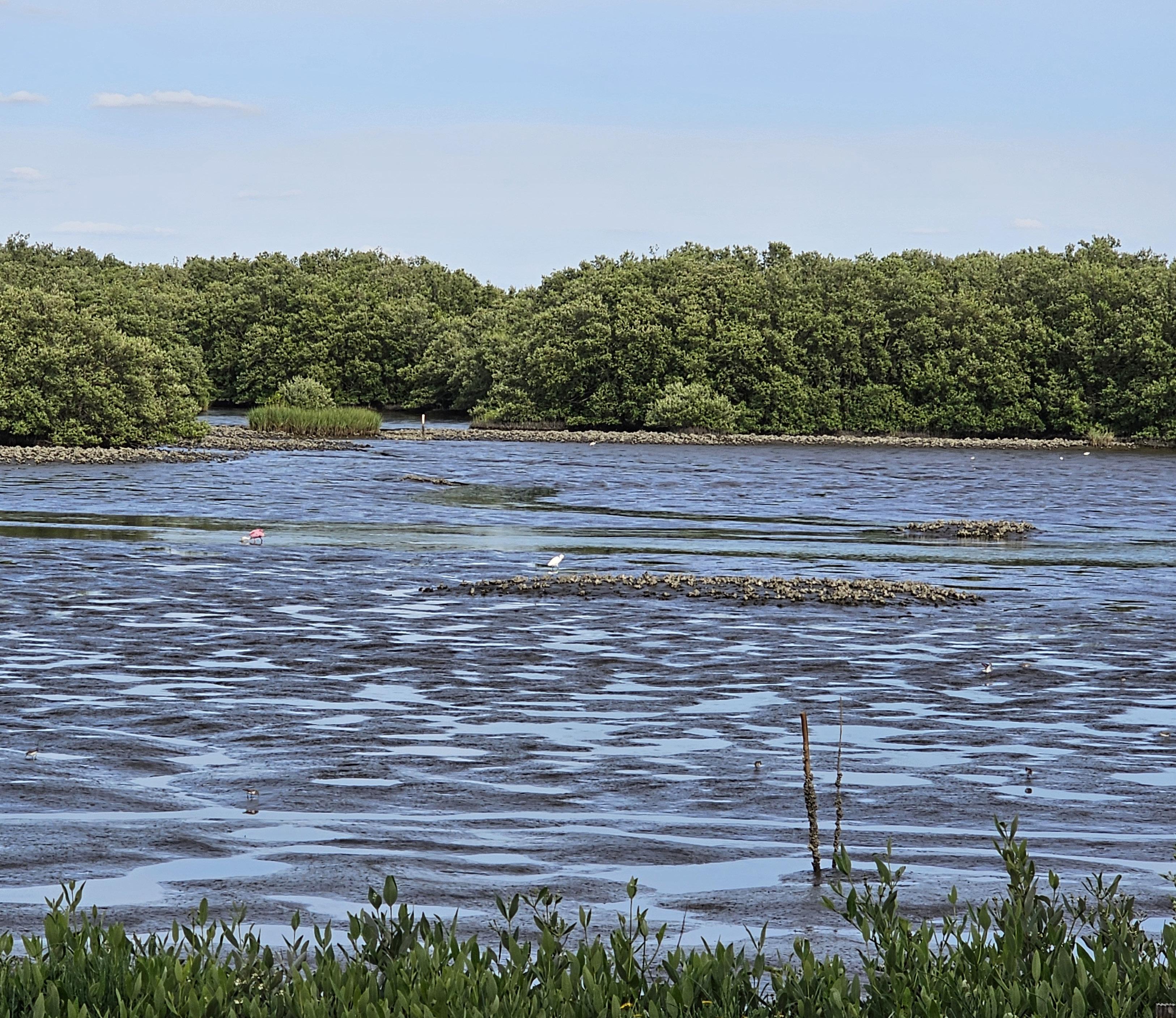
By Sharon Ryan
Led by Nina Stark, Ph.D., an associate professor in the Department of Civil & Coastal Engineering, this ambitious initiative brings together an interdisciplinary team of researchers from five universities across the country. The project focuses on understanding the geomechanical properties of tidal mudflats, which span vast coastal areas worldwide, pose navigation hazards and remain poorly understood.

“A vital piece of this research is measuring the geomechanical properties of these environments such as their hardness or softness, and how they change over time,” explained Stark. “This will help us map out, through the use of field studies and satellite imagery, the safe navigation of these areas, which has been a major challenge for research, recreational, commercial and military activities.”
Tidal flats are notoriously dangerous and result in fatalities each year from people getting stuck or stranded. Our goal is to predict which areas are safe to cross, whether on foot, by vehicle or by boat,” said Stark. “This is especially crucial for military and emergency services that need to navigate these areas quickly and safely.
only advancing scientific understanding of tidal flats but also tackling real-world challenges faced by those who navigate these landscapes, including military and emergency services.
To support this effort, Stark is expanding the team by hiring a research scientist, a postdoctoral researcher and a Ph.D. student, further strengthening the project’s expertise and capacity. A key factor in the project’s success is the experienced technical staff at the Center for Coastal Solutions (CCS), where Stark serves as associate director for field operations. Their expertise has been essential in scaling the research, and they also mentor students alongside researchers — providing hands-on training, developing technical skills and ensuring safety in the field.
“This project is a huge undertaking,” said Stark. “The team is really fantastic, and having access to CCS’s experienced technical staff allows us to hit the ground running, which wouldn’t be feasible if we had to rely solely on students or temporary staff.”
The success of this project could have a significant impact on improving coastal safety, naval operations and advancing scientific knowledge about these vital yet hazardous environments.


The research spans several disciplines, including geotechnical engineering, geophysics, geochemistry, ecology and oceanography, with the goal of developing better tools to predict which areas of muddy tidal flats are safe to cross. Stark and collaborators will conduct fieldwork across a range of field sites, from subtropical to subarctic regions, to better understand the conditions that determine safe navigation.
In addition to Stark, the team includes Sungyoon Jung (University of Florida), Julie Paprocki (University of New Hampshire), Emily Eidam (Oregon State University), Kelly Dorgan (University of Texas) and Joey Yang (University of Alaska Anchorage). Together, they are not

By Megan Sam
Could hurricanes be fueling the spread of microplastics and harmful bacteria in our oceans? With support from a National Science Foundation (NSF) RAPID grant, Chamteut Oh, Ph.D., an ESSIE assistant professor, is launching a new research project to investigate how back-to-back storms might accelerate the spread of antibiotic resistance — the ability of bacteria to survive treatments like antibiotics — in coastal waters. He suspects that microplastics could act as tiny “rafts” for bacteria, allowing them to grow, exchange genes, and persist in marine environments.
In 2024, Hurricanes Helene and Milton made landfall just two weeks apart — on Sept. 26 and Oct. 9, respectively — triggering severe flooding along Florida’s Gulf Coast. The storms overwhelmed sewage systems, releasing millions of gallons of untreated wastewater into local waterways. Hurricane Milton intensified over unusually warm Gulf ocean waters, creating prime conditions for Vibrio bacteria to multiply rapidly. After the storms, the Florida Department of Health reported that cases of Vibrio vulnificus — also known as “flesh-eating bacteria,” which can cause life-threatening infections — more than doubled in the area. Other Vibrio species were also detected.
Since freshwater bacteria typically cannot survive in saltwater, storm surge and the presence of microplastics may help them form biofilms and persist in coastal waters.
The project team, co-led by ESSIE Assistant Professors and CCS affiliate faculty members Elise Morrison, Ph.D., and Sungyoon Jung, Ph.D., will also test whether antibiotic resistant genes (ARGs) have been transferred from freshwater bacteria to marine bacteria. To test this hypothesis, they will employ interdisciplinary analytical techniques, including metagenomic analysis and stable isotope analysis. If freshwater bacteria with resistance genes can persist and pass ARGs to Vibrio, it would suggest that storm-driven flooding could be making Vibrio strains more resistant to antibiotics. Additionally, the team will monitor how long these ARGs stick around in coastal waters by collecting water samples throughout the year.

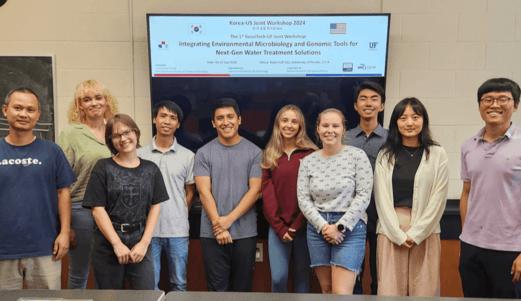
“If ARGs from freshwater bacteria, potentially released from wastewater, are transferring to marine bacteria, the impact of hurricanes could last much longer than we previously thought,” said Oh. “This could create a worst-case scenario where infections become harder to treat, posing risks to both marine life and human health.”
Oh’s team collected water samples from the Lower Tampa Bay to Charlotte Harbor area in January 2025 and will continue their analysis through September. Their findings will shed light on how hurricanes and pollution interact, guiding efforts to improve water quality and reduce longterm risks.
To explore whether hurricane-driven floodwaters spread antibiotic resistance between freshwater and marine bacteria, Oh and Khuong will search for antimicrobial-resistant freshwater bacteria in coastal biofilms. Biofilms are protective layers where bacteria exchange genetic material, and they often form on microplastics.
“While we don’t have strong evidence that the hurricane caused long-lasting impacts yet, many scientific findings suggest that hurricanes can significantly affect water quality for extended periods,” said Oh. “Even if the water appears to return to normal, we can’t say for certain that it is completely safe. It’s important for the public to remain cautious to protect themselves from potential lingering water quality issues.”
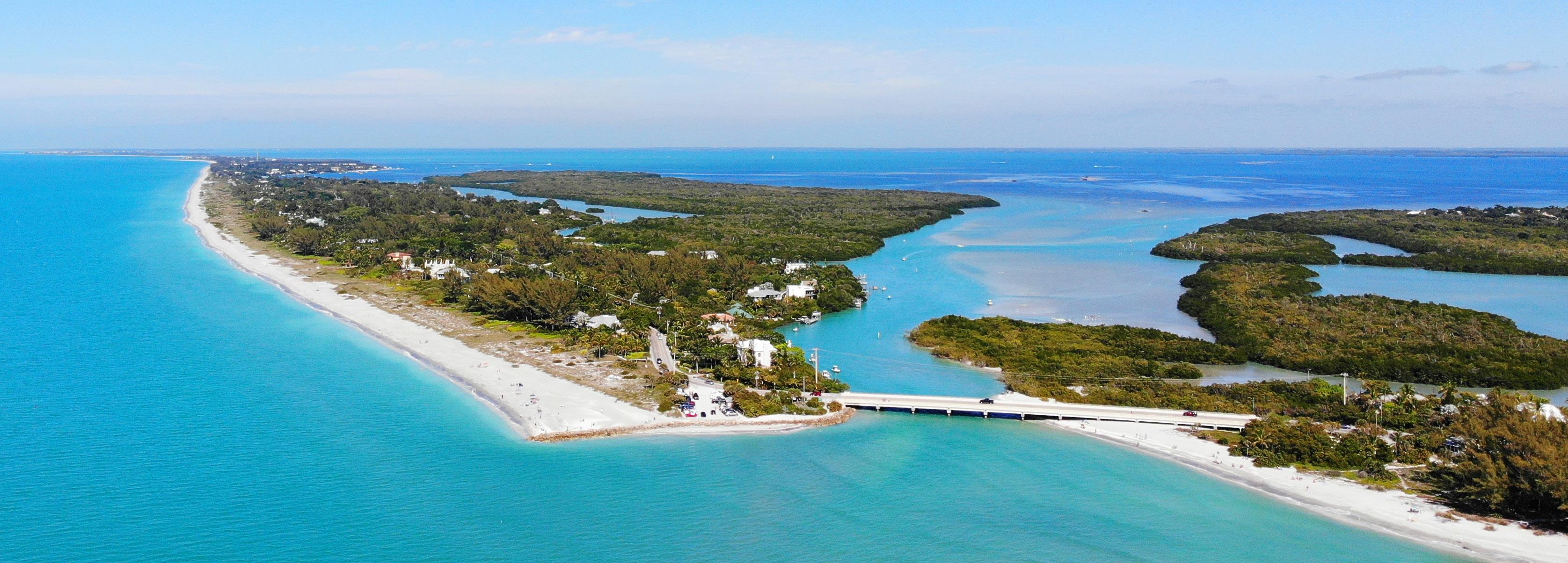
By Megan Sam
Congratulations to CCS affiliate faculty members Marc Hensel and Elise Morrison, who were awarded Gulf Research Program (GRP) Early-Career Research Fellowships by the National Academies of Science, Engineering and Medicine. This prestigious fellowship provides rising scientific leaders with the resources to build partnerships and pursue innovative research that strengthens coastal communities and ecosystems. With funding and mentorship, the GRP offers the independence, flexibility and support essential at this pivotal stage in their careers.
“Florida could be a national leader in climate change resilience,” said Hensel, a research assistant professor at the University of Florida Nature Coast Biological Station (UF NCBS). “This program and award set Elise and I up perfectly to contribute to that. It helps us hit the ground running with research addressing the Gulf of Mexico and climate change while connecting us with other researchers tackling similar questions.”
The GRP was created after the 2010 Deepwater Horizon oil spill to reduce the risks of future offshore oil spills. Its goal is to support Gulf communities by improving their ability to predict, prevent and recover from similar disasters down the road. Hensel and Morrison are two of eight fellows selected nationwide for the environmental protection and stewardship track. Fellows in this track will advance nature-based solutions to protect Gulf ecosystems and communities from climate change threats, while also providing benefits such as clean water and air.

This focus aligns with Hensel’s research on how upstream management impacts coastal ecosystems. For example, he looks at long-term trends to see how factors like land-use management, land-use changes and climate extremes affect water quality. Since water quality directly influences seagrasses and the fish populations that rely on
them, his work helps inform management strategies to improve water quality to promote seagrass health.
“Effective management and prediction are based on a detailed knowledge of the past,” said Hensel. “But climate scientists tell us the future will look very different from the past. We’re seeing new extremes, unique combinations of stressors, and different species. I hope my research, which explores whether past strategies will remain effective in the long term, will be applicable to different regions along the Gulf Coast as we chart this unprecedented future.”

“I’m ready to bring everything I’ve learned back to Florida.”
Morrison’s fellowship will support her research into how human activities have altered the movement of carbon and nutrients to coastal areas, and how these changes impact water quality and essential coastal ecosystems.
“I’m interested in disentangling the factors that influence coastal biogeochemistry and ultimately, water quality,” said Morrison, an assistant professor in the UF Department of Environmental Engineering Sciences. “By better understanding the key drivers, like the microbes changing organic matter, we can then understand how management strategies will influence the mechanisms that drive water quality.”
Five other fellows have joined the GRP’s education research track, which supports the advancement of science and environmental education. Both Hensel and Morrison are eager to collaborate across sectors and disciplines with their new colleagues to effect positive, lasting change.
“This fellowship will be a great catalyst for advancing our current research and opening doors to new opportunities,” said Morrison. “I’m excited to see how this cohort of researchers will unite to address key challenges facing the Gulf.”

By Ines Aviles-Spadoni
Ian Moore, a student in the online Master of Urban and Regional Planning (MURP) degree program at UF, won second place in the American Planning Association’s (APA) Transportation Planning Division Student Paper Competition for his paper titled “A Review of the Socioeconomic Impacts of Alaska’s Unique Transportation Infrastructure.” Moore received the award during the recent National Planning Conference in Denver, which was held March 29 to April 1.
“Receiving an award from the American Planning Association for my research and writing has been both a personal and a professional validation of my efforts and will continue to motivate me as I approach the end of this program,” Moore said.
The paper was written as an assignment in URP 6716 –Transportation Policy and Planning, a course taught by Ruth Steiner, Ph.D., a professor in UF’s Department of Urban and Regional Planning. Steiner is also a long-time affiliate of the University of Florida Transportation Institute (UFTI).
"From the first time we discussed the paper, I knew it was going to be different than the papers of other students,” Steiner said.
“Throughout the years, few students have written papers on air travel. Ian’s paper is unusual in that it looks at a mode of travel that is essential to the economic and social well-being of residents throughout Alaska.”
As a graduate student in the MURP program, Moore also works as an airport planner for the Alaska Department of Transportation and Public Facilities (Alaska DOT and PF) at the Ted Stevens International Airport. For this assignment, he decided to focus on equity and fairness in transportation because he had been interested in these issues and thought it was important to understand how they fit into the overall transportation system. Furthermore, he wanted to explore how his work as an airport planner could inform the socioeconomic impacts of Alaska’s transportation infrastructure.
Alaska’s topography and oftentimes limited road infrastructure make air travel an important mode of transportation for many
communities. Moore’s paper takes a look at the Alaskan air travel landscape and focuses on accessibility for various socio-economic groups. His research paper found that simply having access to air travel doesn’t necessarily mean that Native Alaskan and lowerincome communities will have better outcomes. What is important to consider are the social and economic challenges faced by these communities and what might prevent an improved transportation system from making a difference.
“I considered whether better air connectivity leads to improved socioeconomic outcomes like higher income, employment, and education levels,” he said. “Surprisingly, the correlation was minor, especially for Alaska Native communities who often didn’t benefit despite being relatively well connected to air services.
This points to deeper equity issues in Alaska’s transportation system.”
Through this paper, Moore hopes that transportation and planning professionals will consider “less resource-intensive and more costeffective substitutions” such as installing better broadband internet access for rural and less connected communities for a better return on investment compared to costly and underutilized physical transportation solutions.
“The high cost and long development time for infrastructure such as additional airports and passenger routes means that we need to be considering more cost-effective alternative solutions that can generate a meaningful impact much more quickly and efficiently,” Moore said.
Steiner was instrumental in developing Moore’s paper and provided valuable guidance throughout this journey, serving as a sounding board as he began his research process and refined his own ideas.
“She really helped me think through my ideas, especially as I came across new information and worked to narrow my focus and define a clear research question,” he said. “Dr. Steiner’s knowledge of where to find transportation data and resources to support my research was incredibly valuable.”
In 2023, Moore began his graduate studies in the online MURP program. His goal was to build a strong theoretical and practical background in urban planning and to accelerate a career transition into the field by developing a portfolio of work showcasing his expertise.
As for what this award means for Moore’s career goals and aspirations, it not only validates the work he is currently doing at the Alaska DOT and PF, but it is a strong motivator as he continues to grow in his career as an airport planner.
“I think it’s important to feel appreciated in your field, and receiving recognition from a professional association like the American Planning Association’s Transportation Planning Division is really encouraging,” he said. “It reinforces that the work I’m doing has value, and it keeps me focused and inspired to keep learning, growing, and contributing.”
By Ines Aviles-Spadoni
I-STREET Manager Pruthvi Manjunatha of the UFTI presented findings from a study on Florida’s paratransit services to the state Transportation Committee on Jan. 14 in Tallahassee.
The study, which was conducted in response to Florida Senate Bill 1380, explored mismatches in the state’s paratransit systems while also recommending a variety of improvements to enhance safety, accessibility, and efficiency. The bill tasked the researchers with looking at in-cabin safety technologies, safety standards for technology installation, booking and tracking (user applications), driver interface and data security practices.
The project, led by Manjunatha, looked at the state of practice in eight counties through interviews and questionnaires with transit agencies. The counties included Alachua, Broward, Duval, Hillsborough, Miami-Dade, Orange, Pinellas and Putnam.
“Five out of eight transit agencies took time during a busy hurricane season and responded to our interview request,” Manjunatha said.
In his presentation, Manjunatha recommended including advanced in-cabin technologies, such as high-definition cameras and automatic restraint systems to improve safety and efficiency. Other recommendations included statewide safety standards, accessible apps with real-time booking and tracking features, and data security measure that would include encryption and access controls.
Manjunatha also recommended expanding service and accessibility for all users and suggested to study the use of mobility hubs, ride-hailing partnerships, and autonomous shuttles to address the state’s long-term paratransit needs.
The presentation reflects UFTI/I-STREET’s commitment to ensuring a reliable transportation system for people with disabilities. The findings provide Florida lawmakers with actionable insights that may pave the way for policies and future investments in the state’s paratransit system.
By Ines Aviles-Spadoni
Sherrilene Classen, Ph.D., professor and chair of the UF Department of Occupational Therapy, is an affiliate of the UFTI who, on May 29, 2025, accomplished the amazing achievement of reaching Mount Everest’s Base Camp at 17,600 feet in the Himalayas.
Coincidentally, May 29 was also the day when Sir Edmund Hillary and his Sherpa, Tenzing Norgay, successfully summited Everest 72 years ago. Classen, along with nine of her friends, traveled to this spectacular part of the world to experience the beauty and awe of Mount Everest and to reflect on the challenges that a person must overcome to lead and persevere through teamwork and determination.
“My most important reflection from this trip is that inspiration is gained when I am ascending heights while defeating limits,” Classen said. “Success is always dependent on great leadership and committed teamwork.”
After reaching Base Camp, the next morning, Classen and four of her friends, including a guide, trekked further up the mountain to an elevation of 18,500 feet, where they reached Kalapatter, a wellknown viewpoint in the Nepali Himalayas.
“We left at 4 a.m. and were in awe as we witnessed a spectacular sunrise, revealing Everest in all her glory at 5:05 a.m.,” Classen said.
Classen’s experience is like a metaphor for the transportation industry because, just like it takes teamwork, determination, perseverance, leadership, a clear direction, and resilience to climb Mount Everest, it also takes the same qualities to conceptualize and build innovative transportation systems that work for everyone.
As an occupational therapist who focuses on ways to make driving and mobility safer for older adults and people with physical disabilities, Classen’s journey to Mount Everest’s Base Camp shows what transportation researchers work to accomplish every day: making sure the that the systems they create, the solutions they come up meet the needs of society.

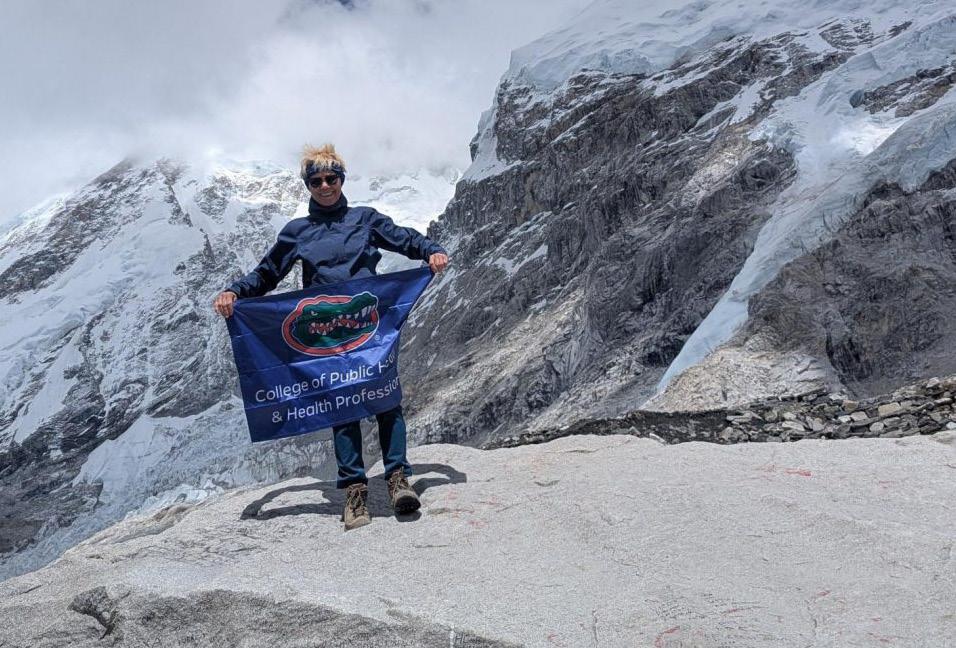


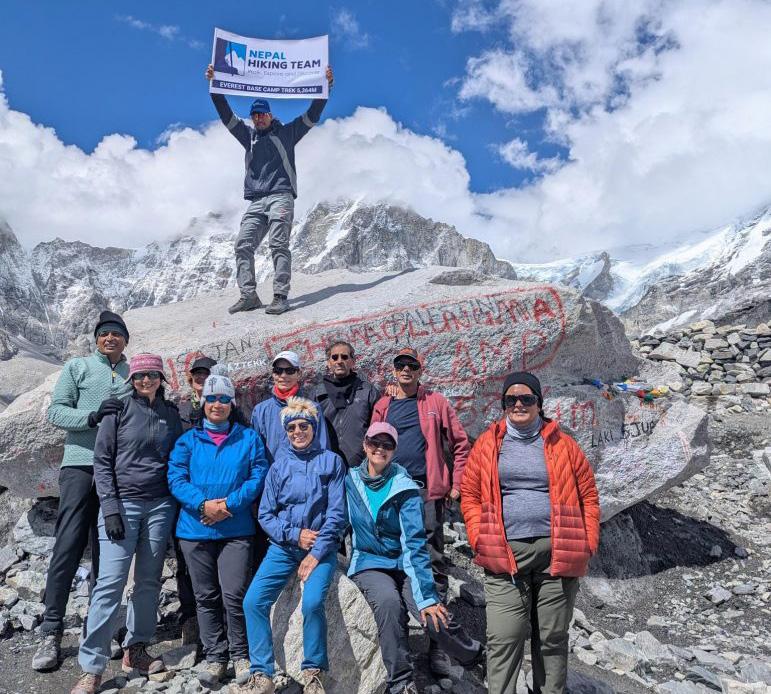
By Ines Aviles-Spadoni
Nithin Agarwal, Ph.D., director of the UFTI’s Transportation Technology Transfer Center (T2), and with his research team, were presented with the 2025 Best Paper Award from the Transportation Research Board’s (TRB) Freeway Operations Committee on Jan. 7 during the 2025 TRB Annual Meeting in Washington, D.C.
The paper “A Safety Service Patrol Case Study in the Use of VehicleMounted Message Boards to Promote Move-Over Behavior” reflects a team effort in advancing freeway safety management strategies.
The research highlights the collaborative innovation of the team, showcasing how vehicle-mounted message boards can effectively encourage drivers to comply with “move over” laws—critical for protecting roadside assistance, first responders, and safety patrol staff.
“This study demonstrates how a small yet strategic intervention can make a significant difference in driver behavior and overall safety,” Agarwal said. “This achievement wouldn’t have been possible without the collective dedication of every team member.”
The research team includes Grady T. Carrick of Enforcement Engineering, Inc., and UFTI-affiliated researchers Siva Srinivasan, Ph.D.; Shraddha Sagar, Ph.D.; including Abiral Aashish and Charles Brown.
“This research underscores the importance of leveraging technology to promote safer behaviors on our roads,” Sagar said. “It also reflects the importance of partnerships that bring practical, datadriven solutions to pressing safety concerns.”
The study was funded by the Florida Department of Transportation (FDOT), further emphasizing FDOT’s unwavering commitment to Target Zero—a vision to eliminate traffic fatalities and serious injuries—and to enhance the safety of first responders and safety patrol staff. This support underscores FDOT’s leadership in supporting research that has both immediate and long-term impacts on roadway safety.
The TRB’s Best Paper Award recognizes research teams that contribute substantially to enhancing the safety, efficiency, and environmental sustainability of freeways and freeway corridors. This achievement reinforces UFTI’s mission to lead transportation innovation through cutting-edge research and collaborative efforts.
Congratulations to the team for achieving this significant accomplishment!

By Dave Schlenker
Truth be told, David Wantman was a little uneasy about being selected as a Distinguished Alumnus from the University of Florida.
The co-founder of WGI, a successful South Florida-based consulting, planning, surveying and design firm, Wantman was not worked up about accepting the honor in front of thousands at the spring engineering commencement. It’s the honor itself that had him questioning, “Why me?”
But make no mistake, UF has good reason to celebrate him, and the humble Wantman is honored. He adores the orange and blue. Proof: During the final tense seconds of UF’s basketball championship against Houston in April, his Garmin watch buzzed with warnings about his heart rate.
The Herbert Wertheim College of Engineering has no doubts about his 2025 induction.
“David Wantman truly embodies the essence of a Gator engineer: dedication, innovation, and a relentless pursuit of excellence,” wrote Engineering School of Sustainable Infrastructure & Environment Chair Kirk Hatfield, Ph.D., in Wantman’s nomination letter.
A 1990 UF engineering graduate, Wantman remains a member of the Dean’s Advisory Board in the College of Engineering. He established the Wantman Group Endowed Fund for Excellence in Civil Engineering in 2012 to support UF’s civil engineering teaching and research.
Hatfield noted Wantman was an active member of the Department of Civil & Coastal Engineering’s (CCE) External Advisory Board from 2005 to 2011. He served on ESSIE’s advisory board starting in 2011, taking the leadership helm in 2022.
“He has consistently provided me with invaluable advice on facultymanagement strategies, emphasizing the importance of fostering collaboration among faculty members at all levels to achieve collective success,” Hatfield added. “His influence has cultivated a culture of dedication and hard work within CCE and ESSIE, contributing to a doubling of ESSIE’s federal research expenditures since 2016.
Wantman said he is proud to be a part the college’s progress and is honored by the award.
“It hasn’t really settled in yet,” he said. “I assume it will when I have to get up on stage. I haven’t been to a graduation where I’ve been on stage since high school, so it should be interesting.”
Wantman’s wife, Kelly, also graduated from UF, as did one of their two daughters.

DAVID WANTMAN, CO-FOUNDER OF WGI
Asked how his UF engineering education affected his success, he said, “This is going to sound a little bit strange, but it’s not so much the calculus and the physics or the chemistry – which I was miserable at it – or the technical skills. It’s more the fact that UF doesn’t hold your hand.
“When I was in school, there were no cell phones. We stood in line for a pay phone in a dorm if we wanted to call somebody. UF obviously wanted their students to do well, but they also weren’t going to coddle you. So the biggest thing I say when I meet students is this university has taught you how to survive.”
After graduation, Wantman worked at his father’s firm for a short time before moving to Tampa to work at a peer’s firm for 10 years.
“Then my second child was born, and my wife wanted to stop work. I had to make some decisions about how to close an income gap because she was making more money than I was. My dad had gone back into business, so I approached him,” he said.
He and his father, Joel Wantman, developed WGI – Wantman Group, Inc. – into a firm with more than 600 employees in more than 20 locations.
WGI’s mission: Creatively transform how our world is envisioned, designed, and experienced. The firm touches many aspects of civil engineering and technology.
“Practical application is something you can relate to – roads, bridges. You turn on your faucet and you want fresh water, that’s us. You turn on your light switch and you want light, that’s us,” he said. “You want the signals to be timed appropriately so that traffic doesn’t sit forever at a signal, that’s us. You decide you want to ride your bike, and you want a bike lane on the road, that’s us.”
This spring Wantman accepted his honor, he understands this is a great time in Gator Nation. Wantman, who attends home football games and whose daughter was a Gator cheerleader, spoke on hallowed ground during commencement, the spot where the basketball team powered its way to an SEC title before heading west to claim the championship.
Read the full story here
Every year, the university honors alumni with the "40 Under 40" awards. These individuals exemplify the spirit of innovation and leadership, making significant contributions to their respective fields.
Wesley Foster epitomizes leadership in engineering and philanthropy. As president and founder of Pacifica Engineering Services, and CEO of the Wesley Foster Foundation, he has significantly impacted both sectors. After graduating with his BSCE from UF, Foster advanced his technical and managerial skills with an ME from UF and an MBA from Louisiana State University.
Under his direction, Pacifica has become a benchmark in engineering with over 100 employees, achieving notable accolades such as the No. 6 Fastest Growing Gator Led Company in 2023 and No. 28 in the 2024 Gator100 and recognition in Inc. Magazine’s 5000 list. His strategic vision extends beyond professional achievements, dedicating significant efforts to societal betterment through the Wesley Foster Foundation. This initiative focuses on enhancing socio-economic conditions via crucial pillars of nutrition and education, providing substantial support.
Colleagues describe Foster as a dynamic innovator and compassionate leader, committed to both community upliftment and professional excellence. His ability to blend empathy with strategic action has not only propelled his companies forward but also nurtured the next generation of engineers and philanthropists. Foster’s career and charitable activities illustrate a profound dedication to building more than just infrastructure; he is dedicated to fostering enduring legacies that resonate within and beyond his immediate community.
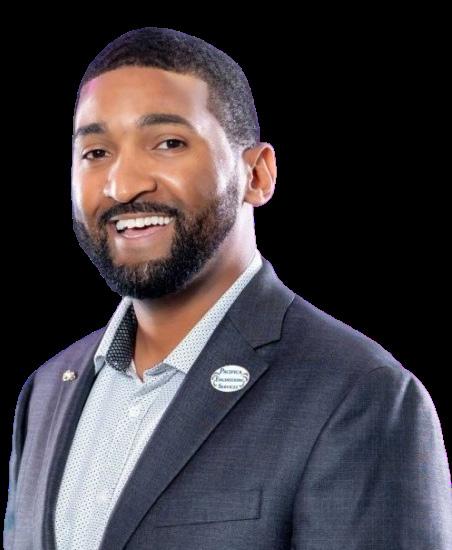
WESLEY FOSTER, PRESIDENT OF PACIFICA ENGINEERING SERVICES

Alumni from the University of Florida have created and guided some of the most innovative and profitable businesses globally. The Alumni Association is proud to recognize these amazing business owners and entrepreneurs through the Gator100. Congratulations to our talented ESSIE alumni who made the 2025 list!
GLENN HARRIS III
BSCE '01 ME, '03 Civil
Alair Homes Sanibel
BRYAN VEITH
BSCE '93
WESLEY FOSTER
BSCE '12, ME '13
Pacifica Engineering Services
REX KIRBY
Veith Engineering & Business Solutions #6 #20 #10 #30
BSCE '80
Verdex Construction

ESSIE.UFL.EDU




